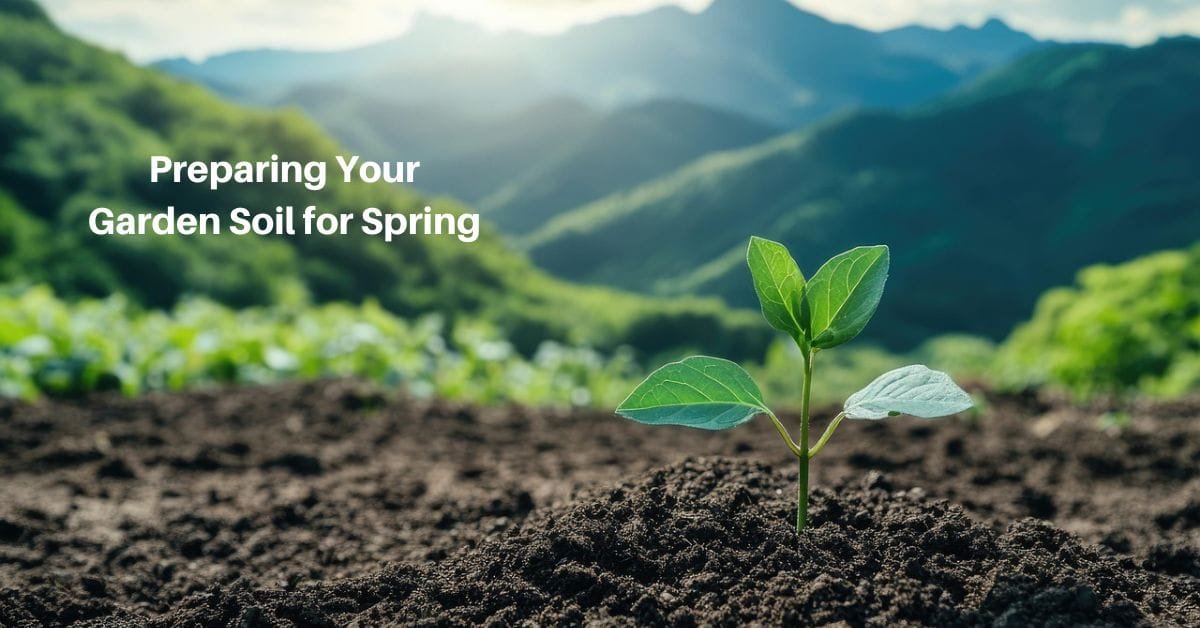A healthy garden has to start with healthy soil. It’s tempting to rush out and start planting the moment the weather warms up, but your soil needs as much attention as the seeds and plants you’ll be adding to it.
Preparing properly in late winter or early spring sets the stage for the entire growing season. Whether your goal is a lush flower bed or a bountiful vegetable harvest, taking time now to condition and enrich your soil will pay off with stronger plants, better yields, and fewer problems down the line.
When we first started gardening, we learned quickly that skipping soil prep often meant stunted plants or mediocre blooms. Once we got into the habit of working the soil each spring by removing debris, testing, and adding organic matter, we noticed our plants growing more vigorously and needing less care throughout the season. Soil care is like laying a strong foundation before building a house: the sturdier the base, the more resilient the structure on top.
Assessing and Testing Your Soil
The first step in preparing for spring planting is to understand the soil you’re working with. Every yard has its quirks. Some of us struggle with heavy clay that compacts easily; others deal with sandy soil that drains too quickly. Most gardeners dream of that perfect middle ground – loam – which holds moisture while allowing air and nutrients to circulate. Knowing what you have helps you make informed choices about amendments and planting.
A simple hands-on test can give you a quick idea of your soil type. Scoop up a handful, moisten it slightly, and try rolling it into a ball. If it forms a sticky lump, it’s likely clay-heavy. If it falls apart instantly, you probably have sandy soil. If it holds together but crumbles when poked, congratulations – you’ve got loam! But however helpful this test may be, it only scratches the surface. For real insight, a soil test is essential.
Home soil testing kits are widely available and easy to use. Most measure pH (how acidic or alkaline your soil is) and provide a rough indication of nutrient levels like nitrogen, phosphorus, and potassium. These three are the “big players” in plant health—nitrogen supports leafy growth, phosphorus aids root and flower development, and potassium boosts overall strength and disease resistance.
Kits vary in accuracy, so if you’re serious about growing vegetables or want to fine-tune your garden, consider sending a sample to your local extension service. They can provide detailed results and personalized recommendations for amendments.
Interpreting your soil test might seem intimidating, but it’s not as complicated as it looks. A pH of 6.0 to 7.0 is ideal for most garden plants, though some, like blueberries, prefer slightly more acidic soil. If your pH is outside that range, adjustments are straightforward: lime raises pH, while sulfur lowers it. Nutrient levels will show where your soil is lacking. For instance, if nitrogen is low, you’ll want to add composted manure or a nitrogen-rich organic fertilizer. If phosphorus is deficient, bone meal or rock phosphate can help.
By assessing your soil before planting, you’re setting yourself up to confront fewer surprises later. Instead of wondering why your tomatoes look yellow or your flowers fail to bloom, you’ll already have provided the right environment for success. This step may take an afternoon, but it saves you weeks of troubleshooting during the season.
Clearing and Amending the Soil
Once you’ve tested and understood your soil, the next step is to physically prepare it.
Winter often leaves behind a mix of dead plant matter, fallen leaves, and other debris. Some organic material can break down naturally and improve the soil, but it’s best to start the season with a clean slate. Old roots and diseased plant remains can harbor pests and fungi that carry over into the new year, so take time to carefully clear away anything that could interfere with healthy growth.
Grab a rake and remove leaves, twigs, and leftover mulch from last season. If you had annuals in the ground, make sure their roots are fully pulled out. Perennials may just need a light trim to remove dead stems, but keep their root systems intact. This clean-up not only tidies your garden but also improves air circulation and helps the soil warm faster as spring sets in.
With a fresh surface, it’s time to start working on the soil’s structure. Even the healthiest soil becomes compacted over the winter due to snow, rain, and lack of disturbance. Compaction makes it harder for roots to spread and for water to penetrate. Lightly tilling or turning the top 6 – 8 inches of soil with a garden fork can loosen it up. Be careful not to over-till – breaking down soil too much can damage its natural structure. A gentle fluffing is usually all that’s needed.
After loosening the soil, add organic matter. This step is one of the most important things you can do for your garden, no matter what kind of soil you started with. Compost is a gardener’s best friend here. A 2 or 3-inch layer spread over the surface and gently worked into the top few inches does wonders for both nutrient content and texture. If your soil is clay-heavy, compost helps improve drainage and aeration. For sandy soil, it boosts water retention and nutrient holding capacity. In short, compost makes any soil better.
Other amendments can be added based on your soil test results. For example:
- Low nitrogen: Add well-rotted manure, blood meal, or alfalfa meal.
- Low phosphorus: Bone meal or rock phosphate works well.
- Low potassium: Wood ash or greensand can be mixed in.
Organic amendments release nutrients slowly over time, which is ideal for steady plant growth. They don’t give the quick “boost” that synthetic fertilizers do, but they’re gentler, more sustainable, and improve soil health long term.
If you’re preparing vegetable beds, this is also a great time to consider crop rotation. Don’t plant the same crops in the same spots year after year. Rotating where you grow tomatoes, beans, or lettuce helps prevent nutrient depletion and reduces the buildup of pests and diseases that target specific plants, since each has its own demands.
Taking these steps now might feel like extra work, but it’s an investment. A garden bed that’s cleared, loosened, and enriched in spring will reward you with strong, resilient plants that need less intervention throughout the season. Think of it as prepping the canvas before you paint—the smoother and better prepared the surface, the more beautiful the final picture will be.
Balancing Moisture and Mulching
Once your soil is cleared and enriched, it’s time to think about water management. Early spring often brings unpredictable weather. Sometimes it’s rainy and soggy; other times it’s surprisingly dry. Healthy soil needs the right balance: moist enough to sustain roots, but not so saturated that it drowns them.
A good way to check your soil’s moisture is with the simple squeeze test. Take a handful of soil and press it together in your hand. If it clumps tightly and drips water, it’s too wet to work with, and you should wait before planting. If it falls apart immediately, it’s too dry and may need a thorough watering. Ideally, soil should form a crumbly ball that breaks apart easily when pressed. That’s the sweet spot where roots can spread, and air and water move freely.
Drainage is a big factor here as well. If your garden soil tends to hold water, consider creating raised beds or adding sand and organic matter to improve aeration. If it dries out too quickly, more compost or even a layer of well-aged leaf mold can help retain moisture. Both extremes – too wet or too dry – can stress plants before they even get a chance to establish.
Mulching is the next step, and it’s one of the most underrated tools in a gardener’s toolkit. A 2 – 3 inch layer of mulch spread evenly across your beds helps regulate moisture by reducing evaporation. It also insulates the soil, keeping it warmer during cool nights and cooler on unexpectedly hot spring days. Plus, mulch helps suppress weeds, which compete with your plants for water and nutrients.
There are many mulch options to choose from. Organic mulches, like shredded bark, straw, or wood chips, gradually break down over time and contribute to soil health. They’re a great choice for vegetable beds and perennial gardens. Inorganic mulches, such as landscape fabric or gravel, won’t add nutrients but can be useful in areas where you’re worried about weed suppression.
If you’re mulching vegetable beds in early spring, wait until the soil has warmed up a bit before applying a thick layer. Mulching too early can keep the soil colder than you’d like, slowing germination and root growth. For perennials or shrubs, however, mulch can go down earlier since it helps protect roots from late-season cold snaps.
Another key tip is to keep mulch away from the base of plants. Piling it against stems and trunks can trap moisture and invite rot or pests. Instead, leave a small circle of bare soil around each plant base so it can “breathe.”
Managing moisture and mulch is about finding balance. Too little water leads to stunted, thirsty plants. Too much, and roots suffocate or rot. Mulch acts like a buffer, evening out the ups and downs of spring weather so your soil stays consistently healthy. By the time summer arrives, you’ll already have a strong foundation in place to withstand hotter, drier conditions.
Final Soil Preparations and Ongoing Care
At this point, your garden soil has been cleared, enriched, and balanced for moisture, which means you’re nearly ready to start planting. Before you do, a few finishing touches will help ensure your soil is in prime condition not just for spring but for the entire growing season.
One of the last steps is leveling and loosening. After all the amending, mulching, and watering adjustments, take a rake or hoe and smooth out your beds. This creates a uniform surface for planting and helps prevent water from pooling in low spots. Breaking up any remaining clumps ensures seeds make good contact with the soil and germinate evenly. For transplants, a smooth bed makes spacing and depth easier to manage.
Testing soil pH is another important final step. Even if you did this earlier, it’s good to get a final check to see how the soil amendments you’ve added are working out.You’re probably in a good place here if you followed the advice above, but it’s helpful to do a final check!
Ongoing care is just as critical as preparation. Spring weather can change quickly, so check your soil regularly. If you get heavy rain, take a few minutes to see whether your mulch layer is intact and whether water is draining properly. If you notice soil compaction or crusting after a storm, lightly cultivate the top layer to keep it loose and breathable. On the other hand, if you hit a dry spell, don’t rely only on rainfall – give your beds a deep soak so water penetrates to the root zone.
Weed management also falls under soil care. Weeds are opportunists; they’ll take advantage of all the nutrients and moisture you’ve worked hard to add. Stay ahead of them by pulling small weeds before they mature, and check around the edges of your mulch for sneaky growth. The less competition your plants face, the more productive they’ll be.
As spring transitions into early summer, your soil preparation pays off. Roots grow deeper and stronger, plants establish more quickly, and your harvests are healthier. The effort you put in now saves you time and frustration later, because healthy soil is resilient soil—it weathers dry spells better, drains after rains more effectively, and sustains plant health all season long.
Preparing your garden soil for spring may feel like a lot of effort, but it’s one of the most important steps you can take as a gardener. From clearing out last year’s growth to enriching with compost, balancing moisture, and adding mulch, each action builds a stronger foundation for your plants. Think of it as setting the stage: once the soil is ready, everything else becomes easier and more rewarding. With good preparation and a little ongoing care, your garden won’t just survive the season – it will thrive.









